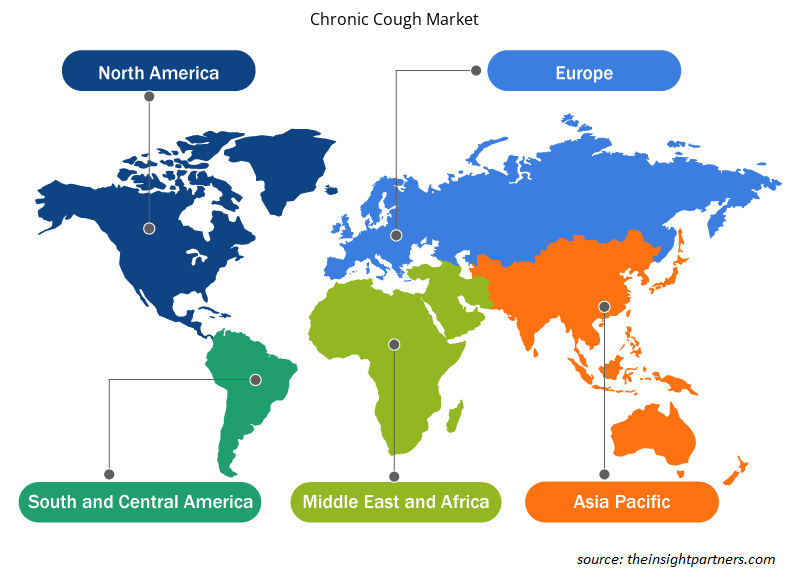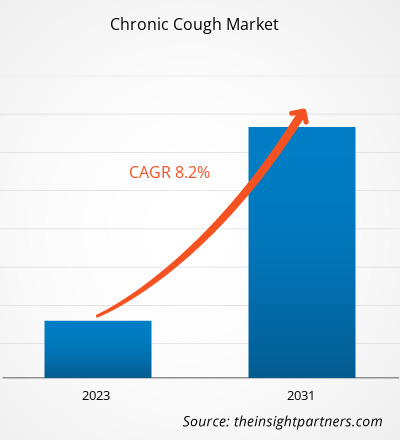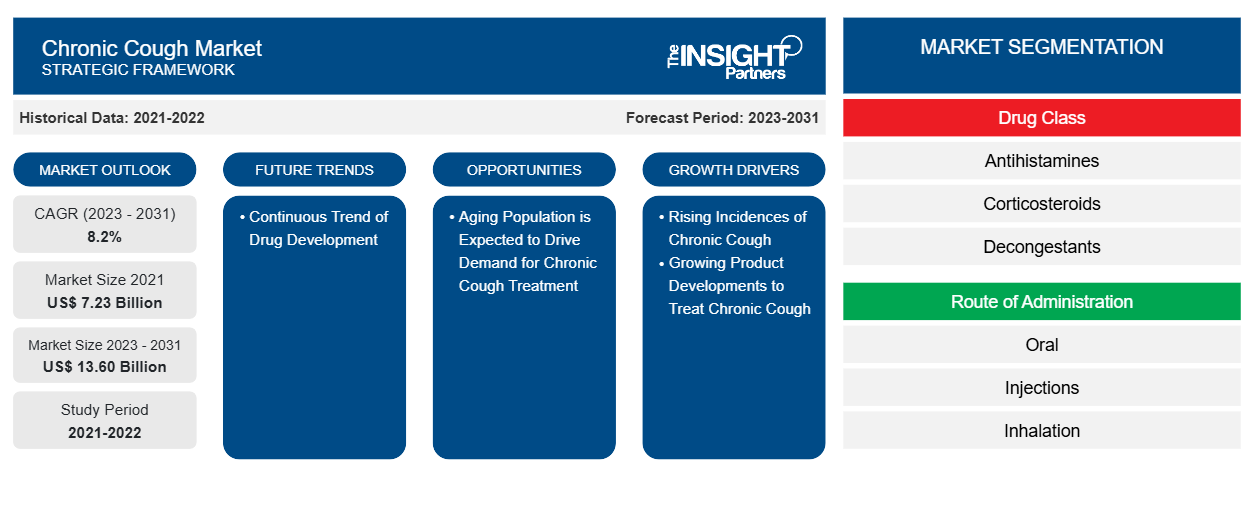La dimensione del mercato della tosse cronica nel 2021 era di 7,23 miliardi di dollari USA e si prevede che raggiungerà i 13,60 miliardi di dollari USA entro il 2031 dai XX miliardi di dollari USA del 2023. Si prevede che il mercato registrerà un CAGR dell'8,2% nel 2023-2031. La crescente consapevolezza riguardo ai problemi respiratori, insieme ai progressi nella ricerca medica e nelle scelte di trattamento e alla tendenza continua nello sviluppo di farmaci, è probabile che rimangano le principali tendenze del mercato della tosse cronica.CAGR of 8.2% in 2023–2031. Rising awareness regarding respiratory problems, along with advances in medical research and treatment choices, and continuous trend of drug development is likely to remain key chronic cough market trends.
Analisi di mercato della tosse cronica
Il mercato globale della tosse cronica è guidato principalmente dalla crescente prevalenza di malattie polmonari croniche, in quanto la tosse persistente è un'indicazione prevalente, e dallo sviluppo di nuovi prodotti per il trattamento della tosse cronica. L'espansione del mercato è guidata da un notevole cambiamento verso la priorità della salute e del benessere respiratorio, nonché da iniziative governative e non governative.
Panoramica del mercato della tosse cronica
Una tosse cronica dura otto settimane o più. Infezioni, asma e reflusso gastrico contribuiscono tutti alla sua prevalenza. I segni e i sintomi del mercato della tosse cronica includono, tra gli altri, una sensazione di liquido che scorre lungo la parte posteriore della gola (gocciolamento retronasale) e mal di testa. Schiarimento regolare della gola, dolore alla gola, raucedine, mancanza di respiro , respiro sibilante, odore acido in bocca o bruciore di stomaco. C'è stato un aumento degli investimenti in infrastrutture sanitarie, strutture diagnostiche e programmi di educazione dei pazienti per migliorare la gestione e la diagnosi precoce della tosse cronica.
Personalizza questo report in base alle tue esigenze
Riceverai la personalizzazione gratuita di qualsiasi report, comprese parti di questo report, o analisi a livello nazionale, pacchetto dati Excel, oltre a usufruire di grandi offerte e sconti per start-up e università
- Scopri le principali tendenze di mercato in questo rapporto.Questo campione GRATUITO includerà analisi di dati che spaziano dalle tendenze di mercato alle stime e alle previsioni.
Driver di mercato e opportunità per la tosse cronica
Crescente adozione della tosse cronica per favorire la crescita del mercato
Anche condizioni come infezioni, malattie polmonari e bronchite possono portare a tosse cronica. Condizioni come l'asma sono in aumento a livello globale; sono comunemente riscontrate tra bambini e adulti. Secondo uno studio intitolato "Prevalenza della tosse cronica, i suoi fattori di rischio e il rischio attribuibile alla popolazione nello studio Burden of Obstructive Lung Disease (BOLD): uno studio trasversale multinazionale" pubblicato a febbraio 2024, la prevalenza della tosse cronica variava dal 2% al 18%. Fumo, asma, broncopneumopatia cronica ostruttiva (BPCO), obesità, sindrome della tosse delle vie aeree superiori (UACS) e malattia da reflusso gastroesofageo (MRGE) sono alcuni dei fattori che sono stati più comunemente associati alla tosse cronica.COPD), obesity, upper airway cough syndrome (UACS), and gastro-oesophageal reflux disease (GORD) are some of the factors that have most commonly been associated with chronic cough.
Si prevede che l'invecchiamento della popolazione stimolerà la domanda di mercato per il trattamento della tosse cronica
Le persone anziane sono più inclini ad avere una tosse cronica e l'avanzare dell'età è il fattore principale della diminuzione dell'immunità. La degenerazione degli organi e dei tessuti sani dovuta al fattore età invita a diverse condizioni di salute. La tosse cronica è una delle condizioni di salute più comuni tra le persone anziane. Il sistema respiratorio inizia a degenerare con l'avanzare dell'età. Pertanto, le possibilità di soffrire di infezioni respiratorie , come polmonite e influenza, aumentano nelle persone anziane.
L'invecchiamento della popolazione sta crescendo in tutto il mondo, poiché i paesi sviluppati e in via di sviluppo stanno assistendo a un tasso di mortalità ridotto. Gli sviluppi nel settore sanitario hanno migliorato la salute pubblica, con conseguente aumento dell'aspettativa di vita. Secondo l'OMS, entro il 2050, la popolazione mondiale di persone di età pari o superiore a 60 anni raggiungerà i 2,1 miliardi. Si prevede che il numero di persone di età pari o superiore a 80 anni triplicherà tra il 2020 e il 2050, raggiungendo i 426 milioni. Pertanto, si prevede che la crescente popolazione geriatrica richiederà probabilmente più trattamenti per la tosse cronica durante il periodo di previsione.
Analisi della segmentazione del rapporto di mercato sulla tosse cronica
I segmenti chiave che hanno contribuito alla derivazione dell'analisi di mercato della tosse cronica sono la classe di farmaci, la via di somministrazione e il canale di distribuzione.
- In base alla classe di farmaci, il mercato della tosse cronica è segmentato in antistaminici, corticosteroidi, decongestionanti, farmaci combinati, antibiotici, bloccanti degli acidi e altre classi di farmaci. Il segmento dei farmaci combinati ha detenuto una quota di mercato maggiore nel 2023.
- In base alla via di somministrazione, il mercato è suddiviso in orale, iniezioni, inalazione, altre vie di somministrazione. Il segmento orale ha detenuto la quota maggiore del mercato nel 2023.
- In termini di canale di distribuzione, il mercato è segmentato in farmacia ospedaliera, farmacia online e farmacia al dettaglio. Il segmento della farmacia ospedaliera ha dominato il mercato nel 2023.
Analisi della quota di mercato della tosse cronica per area geografica
L'ambito geografico del rapporto sul mercato della tosse cronica è suddiviso principalmente in cinque regioni: Nord America, Asia Pacifico, Europa, Medio Oriente e Africa, e Sud e Centro America.
Il Nord America ha dominato il mercato della tosse cronica. La crescente domanda di prodotti da banco (OTC) è un fattore principale che si prevede guiderà la crescita dei ricavi della regione nel periodo di revisione. Inoltre, un numero crescente di casi di tosse cronica, una popolazione anziana in rapida crescita, un crescente inquinamento dei veicoli e una crescente consapevolezza sui farmaci avanzati sono alcuni degli altri fattori che guidano la domanda di prodotti per la tosse.
Approfondimenti regionali sul mercato della tosse cronica
Le tendenze regionali e i fattori che influenzano il mercato della tosse cronica durante il periodo di previsione sono stati ampiamente spiegati dagli analisti di Insight Partners. Questa sezione discute anche i segmenti e la geografia del mercato della tosse cronica in Nord America, Europa, Asia Pacifico, Medio Oriente e Africa e America meridionale e centrale.

- Ottieni i dati specifici regionali per il mercato della tosse cronica
Ambito del rapporto di mercato sulla tosse cronica
| Attributo del report | Dettagli |
|---|---|
| Dimensioni del mercato nel 2021 | 7,23 miliardi di dollari USA |
| Dimensioni del mercato entro il 2031 | 13,60 miliardi di dollari USA |
| CAGR globale (2023-2031) | 8,2% |
| Dati storici | 2021-2022 |
| Periodo di previsione | 2023-2031 |
| Segmenti coperti | Per classe di farmaci
|
| Regioni e Paesi coperti | America del Nord
|
| Leader di mercato e profili aziendali chiave |
|
Densità dei giocatori del mercato della tosse cronica: comprendere il suo impatto sulle dinamiche aziendali
Il mercato del mercato della tosse cronica sta crescendo rapidamente, spinto dalla crescente domanda degli utenti finali dovuta a fattori quali l'evoluzione delle preferenze dei consumatori, i progressi tecnologici e una maggiore consapevolezza dei benefici del prodotto. Con l'aumento della domanda, le aziende stanno ampliando le loro offerte, innovando per soddisfare le esigenze dei consumatori e capitalizzando sulle tendenze emergenti, il che alimenta ulteriormente la crescita del mercato.
La densità degli operatori di mercato si riferisce alla distribuzione di aziende o società che operano in un particolare mercato o settore. Indica quanti concorrenti (operatori di mercato) sono presenti in un dato spazio di mercato in relazione alle sue dimensioni o al valore di mercato totale.
Le principali aziende che operano nel mercato della tosse cronica sono:
- Novartis AG
- Teva Pharmaceutical Industries Ltd
- Glaxo SmithKline plc
- Società per azioni Bayer
- Mylan Italia
- Amneal Pharmaceuticals Inc
Disclaimer : le aziende elencate sopra non sono classificate secondo un ordine particolare.

- Ottieni una panoramica dei principali attori del mercato della tosse cronica
Notizie di mercato e sviluppi recenti sulla tosse cronica
Il mercato della tosse cronica viene valutato raccogliendo dati qualitativi e quantitativi dopo la ricerca primaria e secondaria, che include importanti pubblicazioni aziendali, dati associativi e database. Di seguito è riportato un elenco degli sviluppi nel mercato della tosse cronica:
- Trevi Therapeutics, Inc., un'azienda biofarmaceutica in fase clinica che sta sviluppando la terapia sperimentale Haduvio (nalbufina orale ER) per pazienti con tosse cronica nella fibrosi polmonare idiopatica (IPF), tosse cronica refrattaria (RCC) e prurigo nodularis, ha annunciato l'avvio del suo studio clinico di fase 2b CORAL che valuta tre dosi di Haduvio rispetto al placebo in circa 160 pazienti con IPF con tosse cronica. (Fonte: Trevi Therapeutics, comunicato stampa, 2023)
- Algernon Pharmaceuticals Inc., una società canadese di sviluppo farmaceutico in fase clinica, è lieta di annunciare di aver concluso l'accordo con Seyltx Inc., una società di sviluppo di farmaci con sede negli Stati Uniti di proprietà privata, per l'acquisizione del programma di ricerca NP-120 ("Ifenprodil") di Algernon. (Fonte: Algernon Pharmaceuticals Inc., comunicato stampa, 2024)
Copertura e risultati del rapporto sul mercato della tosse cronica
Il rapporto "Dimensioni e previsioni del mercato della tosse cronica (2021-2031)" fornisce un'analisi dettagliata del mercato che copre le seguenti aree:
- Dimensioni e previsioni del mercato a livello globale, regionale e nazionale per tutti i segmenti di mercato chiave coperti dall'ambito
- Dinamiche di mercato come fattori trainanti, vincoli e opportunità chiave
- Principali tendenze future
- Analisi dettagliata delle cinque forze PEST/Porter e SWOT
- Analisi di mercato globale e regionale che copre le principali tendenze di mercato, i principali attori, le normative e gli sviluppi recenti del mercato
- Analisi del panorama industriale e della concorrenza che copre la concentrazione del mercato, l'analisi della mappa di calore, i principali attori e gli sviluppi recenti
- Profili aziendali dettagliati
- Analisi storica (2 anni), anno base, previsione (7 anni) con CAGR
- Analisi PEST e SWOT
- Valore/volume delle dimensioni del mercato - Globale, Regionale, Nazionale
- Industria e panorama competitivo
- Set di dati Excel
Report recenti
Testimonianze
Motivo dell'acquisto
- Processo decisionale informato
- Comprensione delle dinamiche di mercato
- Analisi competitiva
- Analisi dei clienti
- Previsioni di mercato
- Mitigazione del rischio
- Pianificazione strategica
- Giustificazione degli investimenti
- Identificazione dei mercati emergenti
- Miglioramento delle strategie di marketing
- Aumento dell'efficienza operativa
- Allineamento alle tendenze normative





















 Ottieni un campione gratuito per - Mercato della tosse cronica
Ottieni un campione gratuito per - Mercato della tosse cronica